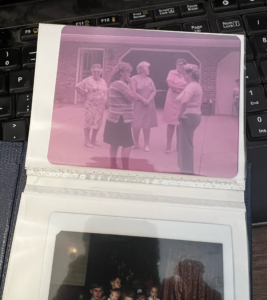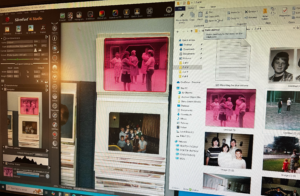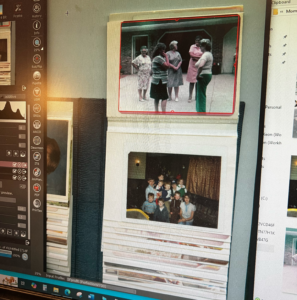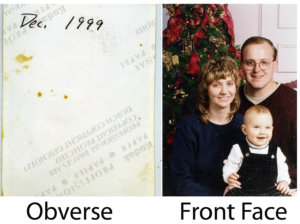 Doesn’t it seem odd that some of Grandma’s photos, collected over a lifetime, fade into a grotesque pink color cast? We also see this with Kodak Ektachrome film transparencies. The problem is that the dyes fade at an uneven rate. It is a simple chemical reaction so trying to isolate the print from the atmosphere is no help. However, the nature of the problem is also the nature of the answer with regard to making digital duplications. An automated levels adjustment is made on the digital version and, in many cases, magnificent color is restored. In other cases, we see merely a dramatic improvement.
Doesn’t it seem odd that some of Grandma’s photos, collected over a lifetime, fade into a grotesque pink color cast? We also see this with Kodak Ektachrome film transparencies. The problem is that the dyes fade at an uneven rate. It is a simple chemical reaction so trying to isolate the print from the atmosphere is no help. However, the nature of the problem is also the nature of the answer with regard to making digital duplications. An automated levels adjustment is made on the digital version and, in many cases, magnificent color is restored. In other cases, we see merely a dramatic improvement.
Here’s What is Important
But what is important to recognize in the services that you receive from W. Cardone Productions is that we have built a color-correction system into our overall process for color and black-and-white print duplication into the digital domain. The process that we use is somewhat seamless and applies to all of the prints (both color and black-and-white) that we process.
Consider an Example

Consider the example illustrated on the right where we see the scaning application, Lasersoft Silverfast Archival Suite. which has scanned in for final scanning the horribly color-cast photo shown above. What is shown is the raw preview scan with no color correction–what you see is what you get. We went ahead and did a final scan and produced the digital color image file shown on the right side of the illustration. The scanner has made a perfect duplication of the badly color-cast photo. Our job is done, we have offered a service to perfection.

Complimentary Automation to the Rescue
Under normal circumstances, the next step would be to simply provide the faithful duplication to the client expecting a grateful “job-well-done” accolade from the client. Alternatively we could offer a color-correction service at an additional fee. Using PhotoShop or any of a number of other photo editing software, in many cases, brilliant color can be restored. But in all cases where there is a horrific color-cast, a radical improvement can be made.
An Overall Manner of Business as a Premise of Operations
At W. Cardone Productions we recognize that the consumer does not explicitly know what he or she wants in a legacy duplication to the digital domain. However, if they obtain a bare-bones duplication of their library, they start discovering wanna-bees that they would like to have had were it possible or had the technology existed.

Your Link to the Original Media
What every consumer will typically recognize upon receipt of a digitized library is the loss of critical archival and historical information. When grandma assembled her photos over a lifetime, she routinely wrote historical information on the back of the photo or collected historically linked photos into one envelope and then wrote notes on that envelope. A typical estate of memories that is given to us may contain literally thousands of photos, many with historical notes written on their backs. If the duplication process was done to simply duplicate the images, recovering lost historical information will be prohibitive. That is, the library is simply duplicated as a large set and delivered in one folder or many folders without regard for the original architecture of storage.
At W. Cardone Productions we make every effort to duplicate, not only your images, but we duplicate the architecture of how those photos were stored. For any one identifiable mode of storage there will be a corresponding folder in your delivered product. The advantage with this approach is that it suddenly makes it possible to link physical media with its corresponding duplication. Uncategorized, it would likely be impossible to locate the original photo of a duplication to merely see if there were any historical hints on it. But with our approach, the task might still be large but instead of sorting through two thousand photos you might only need to sort through twenty photos making the task doable.
